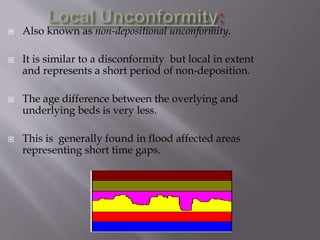Unconformity vivek-131216012700-phpapp02
- 1. By- Vivek Priyadarshi M.Sc in Petroleum Geosciences Sem - I
- 2. An unconformity is a surface of erosion that separates the younger strata from older rocks. It is one of the most common geological feature found in rocks or in succession. It is different then all other geological structures viz. the fold, joints and faults Unconformities are resulted due to tectonic activity in form of uplift or subsidence of land It is referred to a period of non-deposition
- 3. Characteristics of Unconformity :- 1. Amount of dip direction :- 2. Difference in Rock Composition :-
- 4. 3. Difference in Structural Feature :- 4. Difference in Fossil Content :-
- 5. • Angular unconformity • When the underlying (older) rocks and overlying (younger) rock strata show some angle w.r.t one another = Angular unconformity. • Here both underlying and overlying rocks are of sedimentary origin.
- 6. Types of Angular Unconformity :- 1. Amount of dip direction :- 2. Difference in Structural Feature :-
- 7. Non-conformity When the underlying rocks are Igneous or Metamorphic (i.e. unstratified) and the overlying younger rocks are sedimentary (stratified) = Non-conformity Essential concept – prolonged erosion must occur to expose the intrusive before burial.
- 8. • Disconformity • Also known as parallel unconformity. • It is formed in areas of lesser magnitude of diastrophism. • When the underlying (older) and overlying (younger) sedimentary rock strata are parallel and the contact plane is an erosional surface = Disconformity
- 9. Also known as non-depositional unconformity. It is similar to a disconformity but local in extent and represents a short period of non-deposition. The age difference between the overlying and underlying beds is very less. This is generally found in flood affected areas representing short time gaps.
- 10. A surface of erosion, covered by residual graded soil. Lack of a sharp contact.
- 11. If two beds or two series of beds are non- parallel on vertical section as exposed in a hill or railway cutting, the surface of contact represents unconformity. The lowest bed above unconformity may usually consist of conglomerate pebbles. Unconformity may be indicated by sharp contrast in the degree of induration.
- 12. Disconformity may be readily recognized in outcrops, road cuts etc. if there is: Sharp contrast in colour of the younger and older bed. Undulated appearance of the plane of unconformity. Radical difference in fossil contents. Variation in lithologic peculiarities in between beds.
- 13. Unconformity represents a break or an interval in deposition of beds and forms a record of time gap. Unconformity indicates a stratigraphical hiatus and represents the period during which the region was a land mass and eroded subsequently. In certain situations unconformity produces potential oil traps and aquifers.
- 14. Unconformity helps visualizing paleogeography of a region. Unconformity is an important structural feature that affects site foundations for engineering works. It generally forms a weak zone.
- 15. Thank U…..














